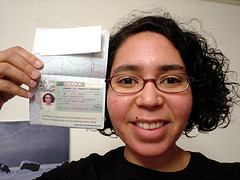Border Crossings Made Easy with a Visa
16 August 2012
A visa is document that allows the bearer to apply for entry into a foreign country. It doesn’t guarantee entry into that country; it simply allows you to present yourself to the immigration officer standing at the port of entry of any country and request entry.
Visa rules are complicated
Countries require visas from visitors for all kinds of reasons – economic, security, political, sometimes even retaliatory – and the rules change all the time depending on current policy and the political season.
Visa requirements also vary widely between countries but most have restrictions:
- It may only be valid for a certain number of days
- It may have a limited number of re-entries
- It may have pre-determined entry and exit dates which may not be chosen by you
- It may specify border crossings you must use
- It may specify what you can do – sightsee or work, but perhaps not both
Of course, all visas come with various fees and expenses.
Some visas can be obtained at the airport or at the embassy of the host country or directly at the border, but some have to be applied for ahead of time and may even require additional documentation such as fingerprints, a detailed itinerary, a recommendation letter from your employer, even hotel reservation confirmations. Headed to Laos? You’ll need to have extra passport photos in hand for your visa.
In fact, visa-entry procedures have become so complicated worldwide, that the leaders of the travel and tourism industry attending the 12th World Travel and Tourism Council Global Summit identified restrictive visa policies as a critical impediment to travel and tourism around the world. They reportedly agreed to find ways to balance the needs of sovereign security with tourism.
What’s your passport got to do with it?
While they are completely separate documents, your passport and visa go hand-in-hand. In most cases, visas come in the form of stickers or stamps in your passport, and because your passport is required to get the visa, you can’t apply for a visa without your passport.
Some countries will deny entry and refuse to issue you a visa if your passport is close to expiring. In some cases, your passport has to be valid for more than six months after the date you intend to depart their country. This means you could be turned away at the border and unable to leave the airport to continue your trip.
Your residency doesn’t have an impact (except in where you go to obtain a visa), but the nationality on your passport does. For this reason, if you are a non-citizen where you currently reside, you cannot rely on local advice as to whether you need a visa to visit another country. Essentially, the locals may not need a visa, but you might. It’s also important to be sure you can be allowed back into your current country of residence. You may need a permanent residence visa in your foreign passport to be allowed to come back home.
Visa mistakes can’t be recovered with travel insurance
Travel insurance plans specify that it’s the responsibility of the traveler to know the passport rules of the country they are visiting. In many cases, tour operators will help their clients apply for and obtain the visa or visas necessary for the tour, but if they don’t – or if they get it wrong – you’re still liable for the problem.
This means a traveler who loses their trip due to a visa problem won’t have the ability to recover their pre-paid trip costs or any unexpected costs that result from the visa mistake from their travel insurance provider.
Steps to ensure smooth border crossings
If you’re traveling to a foreign country or countries, you’ll want to implement these steps to ensure smooth border crossings:
- Check the entry and exit requirements for the country you’re visiting and remember your points of entry. Argentina currently doesn’t require U.S. citizens to have a visa for visits up to 90 days, but you’ll need one if you cross into Brazil, for example.
- Give yourself plenty of time – some visa applications are quick and some take weeks or longer.
- Understand that getting a visa isn’t guaranteed – any country can refuse to issue a visa without explanation.
- Check the visa when you get it. It’s considerably less convenient to fix a problem once you’ve arrived at the border.
Damian Tysdal is the founder of CoverTrip, and is a licensed agent for travel insurance (MA 1883287). He believes travel insurance should be easier to understand, and started the first travel insurance blog in 2006.

